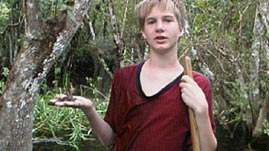Teachers' Domain - Digital Media for the Classroom and Professional Development
User: Preview


Source: ZOOM
Have you ever wondered why a particular plant grows near your home or why you find so many rocks of the same type in one area? Usually, there isn't a single simple answer to such questions. This is because many of Earth's materials, processes, and organisms are inextricably linked to many others. Such is the case with the unique environment of Florida's Everglades. In this adapted video segment, ZOOM guest Tommy takes you into the Everglades and describes what he loves about mucking around in the swamp.
The natural world is far too large and complex for any one person to know every aspect of science. In fact, it would even be impossible for one person to know all there is to know about a particular region, such as the Everglades. Scientists typically specialize in more specific fields of study, such as geology, oceanography, meteorology, biology, and so on. Even within these disciplines there are subspecialties, such as hydrology and ecology.
However, this does not mean that various aspects of the world are unconnected. For example, many ecological questions about a particular region cannot be answered without an understanding of that area's geochemistry or its weather and climate. Increasingly, scientists are creating links among their specialties by viewing their research in terms of the Earth system. The Earth system is described as the interconnected relationships between Earth's lithosphere, hydrosphere, atmosphere, biosphere, and space.
The lithosphere is Earth's rigid outer shell, which includes the crust and the uppermost part of the mantle, which is the layer below the crust. This system describes both the materials that make up Earth and the processes that form and change these materials.
The hydrosphere is made up of all the water in Earth's oceans, lakes, rivers, and glaciers, as well as the water in the atmosphere. This system helps explain the distribution of plants and animals, as well as some of the processes responsible for geological changes.
The atmosphere is the collection of gases surrounding Earth. Like the hydrosphere, the components of the atmosphere are essential to life on the planet and also play a role in geological transformations.
The biosphere is the collection of organisms on Earth. This system is not only affected by the other systems, but it also plays a role in geological weathering processes and impacts the chemical makeup of the hydrosphere and atmosphere.
It is impossible not to also recognize the interdependence of the four Earth systems. In every region of the world, these systems combine to create unique environments. The Everglades is no exception.
 Loading Standards
Loading Standards Teachers' Domain is proud to be a Pathways portal to the National Science Digital Library.
Teachers' Domain is proud to be a Pathways portal to the National Science Digital Library.
